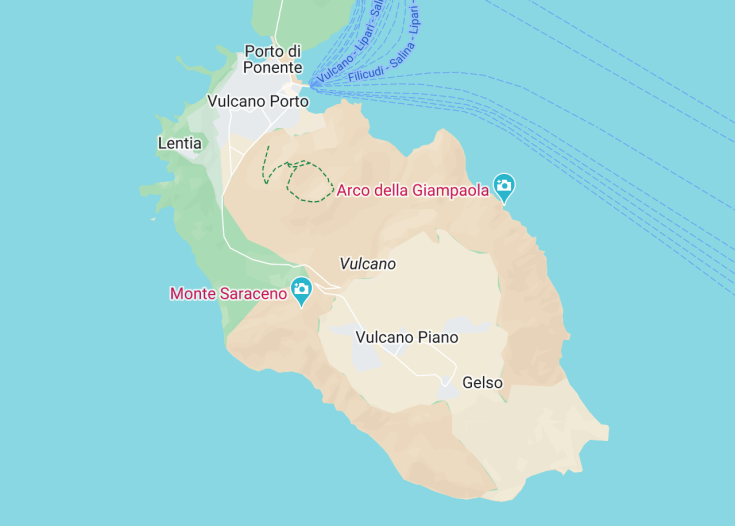Vulcano, one of the Aeolian Islands in Italy, is renowned for its dramatic landscapes shaped by volcanic activity. This island offers a unique blend of natural beauty ranging from therapeutic sulfuric mud baths and hot springs to stunning black sand beaches. The Gran Cratere, a hikeable volcano, provides panoramic views of the Mediterranean Sea, epitomizing the island’s allure. Visitors are enchanted by the rich history, vibrant culture, and local cuisine, making Vulcano a fascinating destination for adventurers and relaxation seekers alike.
Prioritize a visit to the therapeutic mud baths early in your trip; their rejuvenating properties are perfect for soothing after travel fatigue.
Don’t miss hiking the Gran Cratere; ensure you wear sturdy shoes and carry water, enjoying breathtaking vistas from the summit.
Top things to do & see in Vulcano
Select the following sights and activities to discover best tickets and tours available in Vulcano.
Vulcano: A Gateway to Geological Wonders
| Country | Italy |
| Time in Vulcano | GMT+1 |
| Language spoken | Italian |
| Population | 715 (2021 data source: Local Government Records) |
| Currency | Euro (€, EUR) |
| Airports |
|
Vulcano, a small volcanic island in Italy, is renowned for its extraordinary landscapes and geological activity. Part of the Aeolian archipelago north of Sicily, Vulcano is steeped in myth and natural beauty. Its most striking feature is the Gran Cratere, the summit of which offers stunning views of the Aeolian Islands and the Sicilian coast. The island draws visitors with its therapeutic mud baths and warm geothermal waters that are said to have healing properties.
Where is Vulcano?
Located north of Sicily in the Tyrrhenian Sea, Vulcano is part of Italy’s Aeolian Islands archipelago.
Distances:
| Route | Distance by car | Time by car |
|---|---|---|
| Milano to Catania | 1055 mi | Approx. 16 hrs |
| Rome to Catania | 537 mi | Approx. 9 hrs |
| Naples to Catania | 371 mi | Approx. 6 hrs |
What is Vulcano famous for?
Vulcano is famous for its dramatic volcanic landscapes, including the active Gran Cratere. It is also well-known for its therapeutic mud baths and geothermal hot springs, attracting tourists seeking natural treatments and spectacular natural scenery.
History
Prehistoric to Ancient Times
Vulcano, one of the Aeolian Islands off the northeastern coast of Sicily, Italy, has a rich history that dates back to prehistoric times, evidenced by archaeological findings suggesting early human presence. The name ‘Vulcano’ itself is derived from the Roman god of fire, Vulcan, indicating the island’s ancient associations with mythology and its famous volcanic activity. The earliest inhabitants recognized the island’s fertile soil, produced by millennia of volcanic eruptions, and its natural resources like sulfur and alum, which were mined extensively.
Medieval to 19th Century
Throughout the medieval period, Vulcano saw a series of dominations starting from the Romans to the Arabs, and later the Normans. Each era left its mark, transforming the island’s landscape and culture. By the 19th century, Vulcano became a subject of scientific study due to its active geology. The Great Eruption of 1888-1890 drew scientists and adventurers alike to its rugged shores to study the phenomena, solidifying its reputation as a natural laboratory.
20th Century to Present
In the 20th century, Vulcano transformed from a scientific outpost into a tourist destination, known for its dramatic landscapes, therapeutic mud baths, and warm, mineral-rich waters. The establishment of the Aeolian Archipelago National Park in 2000 further promoted conservation efforts and sustainable tourism, adapting its rich natural heritage into an eco-friendly tourist experience that supports the local economy while preserving its unique environment.
Visit Vulcano
What to see and do in Vulcano
Vulcano offers a smorgasbord of attractions and activities for any adventurous spirit or nature lover. Explore the Gran Cratere, the active volcano that lends the island its name, offering panoramic views of the Aeolian Islands from its rim. The trek to the summit is a must for any visitor. Relax in the therapeutic mud baths of Laghetto di Fanghi, renowned for their healing properties, before washing off in the nearby hot sea waters of Baia di Levante. Dive into crystal clear waters for snorkeling or enjoy a boat tour around the island to experience its dramatic coastline. Vulcano’s black sand beaches, such as Spiaggia delle Sabbie Nere, provide a unique seaside experience contrasted with lush greenery and the azure sea.
Festivals and Events in Vulcano
Despite its quaint size, Vulcano hosts a variety of cultural festivals and events, particularly during the summer months. The Vulcanalia, held annually in August, celebrates the island’s volcanic nature with art exhibitions, workshops, and local cuisine, all set against the backdrop of the simmering Gran Cratere. The Aeolian Islands Regatta, also in summer, is a sailing event that sees boats from around the world competing in the beautiful waters surrounding the islands.
Best time to visit Vulcano
For ideal weather and vibrant local events, the best time to visit Vulcano is from late spring to early fall, particularly between May and September. During these months, the weather is pleasantly warm, perfect for beach activities, hiking, and exploring the island’s natural and historic sites. Additionally, the island’s peak tourist season offers the full cultural experience of local hospitality and festivities.
Is Vulcano worth visiting?
Vulcano is undoubtedly worth visiting for its unique blend of natural beauty, geological wonders, and rich historical culture. It offers an unparalleled experience, from hiking active volcanoes and indulging in natural spa treatments to exploring ancient myths and enjoying local Aeolian cuisine. This small island encapsulates the charm and mystery of a primeval natural world coexisting with a vibrant contemporary community, making it a must-visit destination for both adventure seekers and those wishing to unwind in serenity.









